This is the mother of all parks – the beginning of what would one day be considered by many as “America’s Best Idea”. It seems fitting that the activities in Yellowstone are basically limitless. There are more opportunities for adventure in this park than you probably even imagine. All you need is a little time… and perhaps the adventurous spirit of John Colter…
Here are some of Park Junkie’s favorite activities in Yellowstone National Park.
Guide to Yellowstone
Hiking in Yellowstone
With more than 1,000 miles of trail weaving throughout 2.2 million acres of high elevation wilderness, Yellowstone is a hiker’s paradise. Indeed, with unparalleled landscapes emerging around every curve in the trail, this place is sort of elite as a hiking mecca. There are so many hiking options in Yellowstone, the subject has its own page. Just click the heading to find your way to the trail.
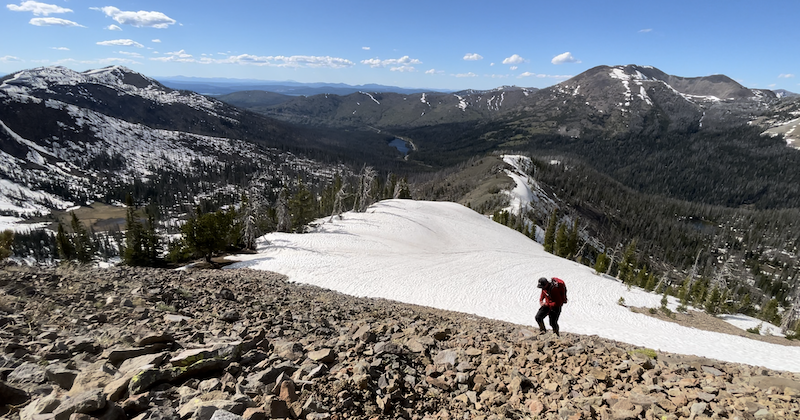
There are so many hiking options in Yellowstone, the subject has its own page. Just click the heading to find your way to the trail. I have included links to YouTube videos from my favorite trails, so you can tag along virtually and see what the trail involves. For trails that I haven’t yet filmed, I link to online resources that I find helpful.
Backpacking in Yellowstone
Yellowstone is a backpacker’s dream. With nearly 300 wilderness campsites sprinkled about the park’s 2.2 million acres, it is unlikely you’ll feel crowded in the backcountry of the world’s first national park.
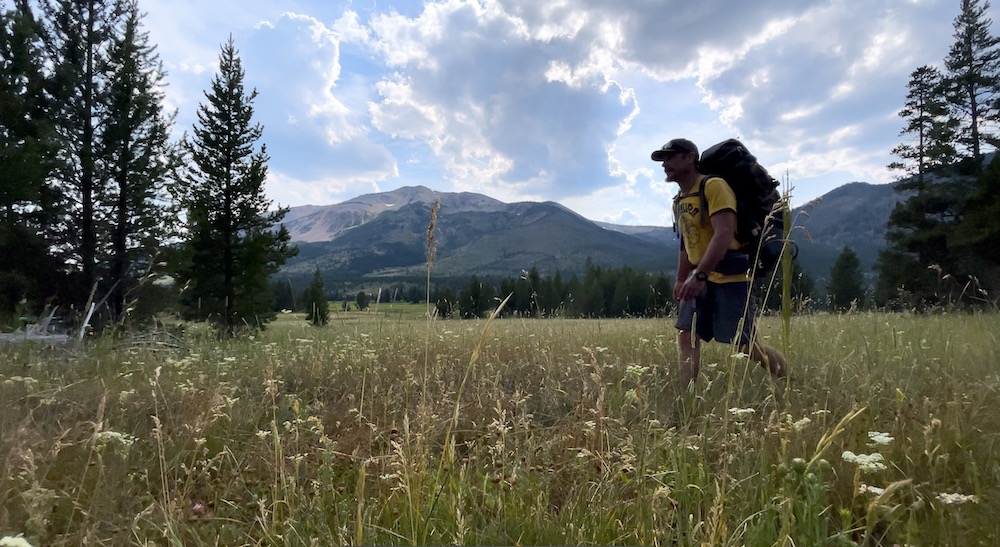
Much of Yellowstone’s surrounding ecosystem is made up of roadless wilderness. In fact, the southeastern Thorofare sections of Yellowstone are the most geographically remote, roadless lands in the lower 48. Solitude seeking hikers can easily insulate themselves in such areas of the park, connecting one long-haul trail to another for weeks on end.
MOREBackcountry travel in Yellowstone is not for the weak of constitution. This is some of the most rugged and intimidating backcountry you will find. A long passage often will include numerous river crossings in rushing waters, encounters with massive grizzly bears, rapidly deteriorating weather conditions, and miles upon miles of struggle through the naturally drawn maze of a magical land… atop one of the largest super-volcanoes this Earth has ever known.
An overnight backcountry permit is required and fires are restricted to established fire rings. Bear restrictions require safe food storage techniques. Bear spray is certainly a must. According to the National Park Service, firearms are not recommended for defense against an attacking bear, but remain permitted in the park according to the laws of each respective state. Nevertheless, park policies may restrict the carry of such device and prevent the discharge of firearms within park boundaries.
If you’ve never been backpacking and are averse to just heading on out there yourself, there are guided trips available. Numerous companies are permitted to operate commercial hikes in the park, so you can just pay someone to escort you through the Yellowstone wilderness.
Hiking Yellowstone’s Boardwalks
Yellowstone is home to more than half of the world’s known active geysers. In fact, Old Faithful’s Upper Geyser Basin is itself home to more than half of such geysers. There’s a lot of crazy activity going on down below the Earth’s surface here, and an eager Park Junkie will undoubtedly want to investigate the bizarre scene for themselves.
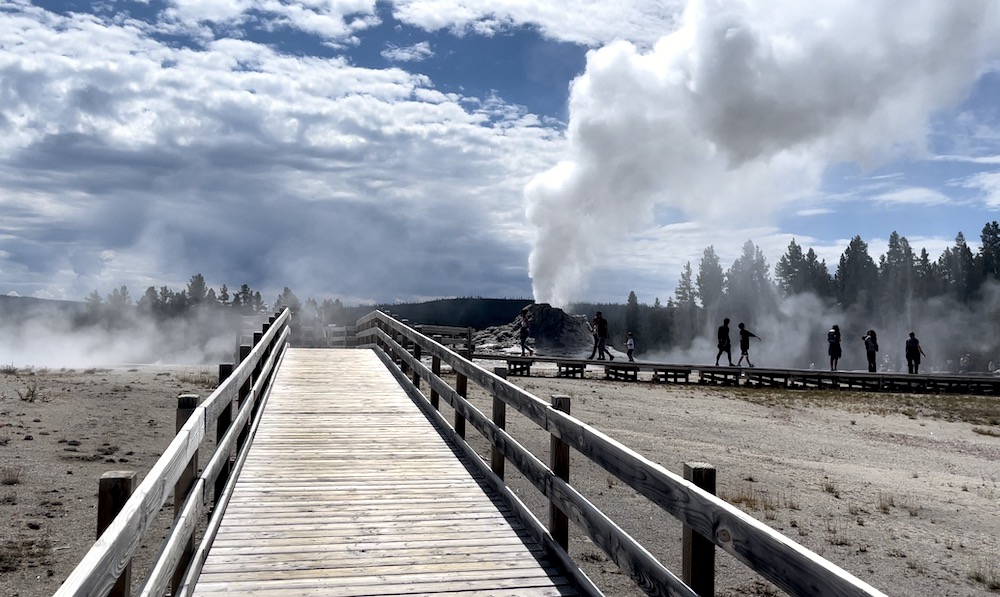
Yellowstone’s thermal features often are made up of unstable ground, with a steaming caldron just below a thin surface of what appears to be solid ground. This makes travel in such areas extremely dangerous. For this reason, many of the trails in these areas are accessed by a series of boardwalks which provide a safe surface upon which to travel through some of the most bizarre landscapes on the planet.
Peak Bagging / Off-Trail Travel in Yellowstone
Yellowstone is vast and anyone who claims to have seen it all is simply a liar, or has clearly lost their ability to reason with themselves. While it may be possible for a human to cover all of the park’s trails, once an eager adventurer decides to head off trail here, this land becomes endless! There are countless routes through the wilderness of this park, and plenty of peaks to keep one chasing summits for decades to come.
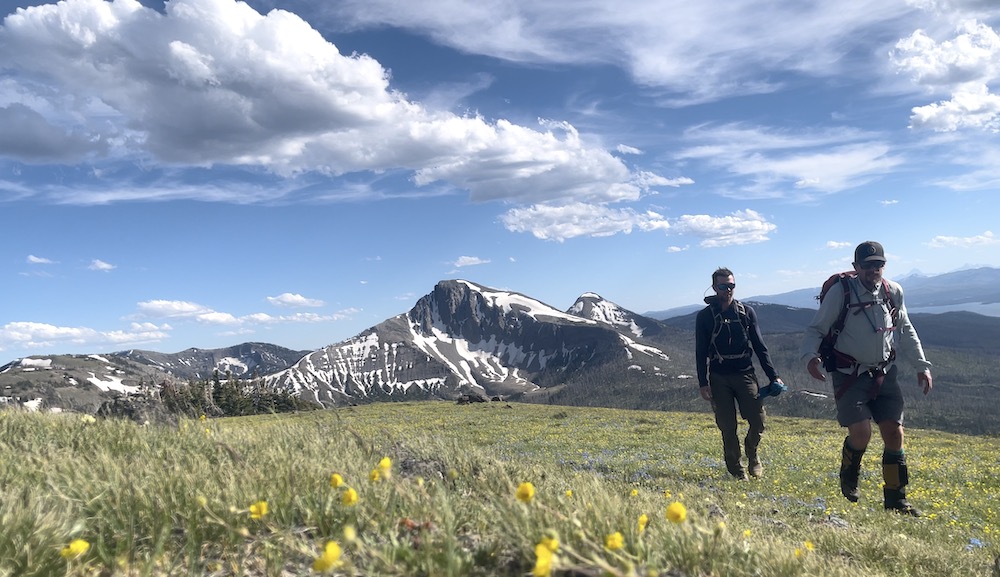
Hikers who choose to venture into the Yellowstone backcountry must be aware that the park’s backcountry is unforgiving. There are no easy exits, and it is easy to become lost. Cellular service is rare and this country is controlled by beasts that can kill a human with the simple swipe of a paw. Do not enter the park’s backcountry without a map, a compass, and ability to use both. Know what you’re doing out here, because this land has killed many who are stronger than you.
Fishing in Yellowstone
Casting into the clear waters of Yellowstone’s scenic rivers is on the bucket list for many anglers the world over. What’s even better than casting into these wild waters? Reeling a beautiful 24″ cutthroat trout into an awaiting net and getting that picture that will prove one’s metal when back home bragging to the chums.
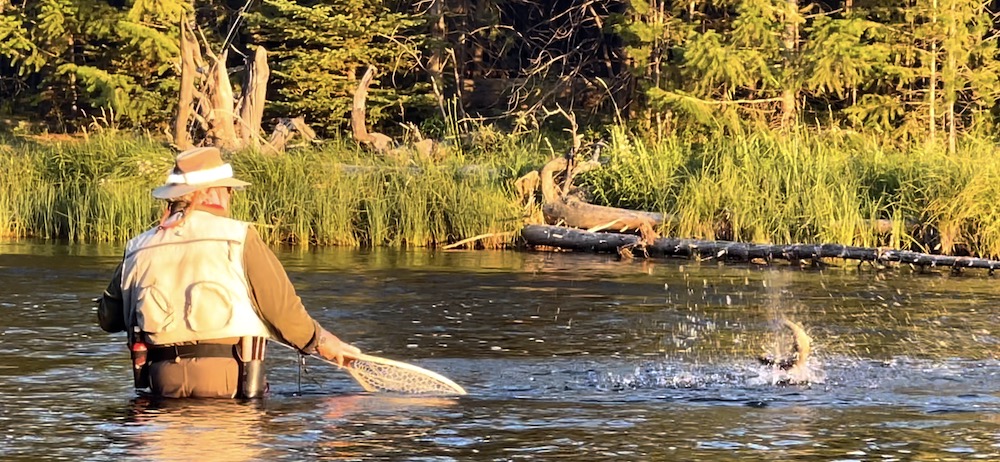
The park service estimates that around 50,000 visitors a year include fishing as a pursuit while visiting the park, and many come specifically to fish. Many choose to fish from shore, while others will don the waders and head out into the flowing waters to cast flies. Others still opt for a boat and try their luck on Yellowstone Lake, casting for lake trout and cutthroat. Lake trout are an invasive species, so if you bring one of these babies in, keep it & eat it…
Fishing in the park requires a Yellowstone Fishing Permit, which the park prefers be purchased online from the corporate folks. A state fishing license is not required. The wise angler will carefully review the rules and regulations before assembling the gear for this trip, as the park limits many practices one may be accustomed to in their home waters.
Boating in Yellowstone
Yellowstone’s lakes provide a unique opportunity to gain a new perspective of the park’s incredible topography. A trip on the water here is a sure fire way to add some great memories to a park visit.
Visitors with motorized craft can opt to hit the open waters of either Yellowstone or Lewis Lake, while those with paddles will have a few more options. All rivers in the park are off limits to boats, except the Lewis River Channel between Lewis Lake and Shoshone Lake.
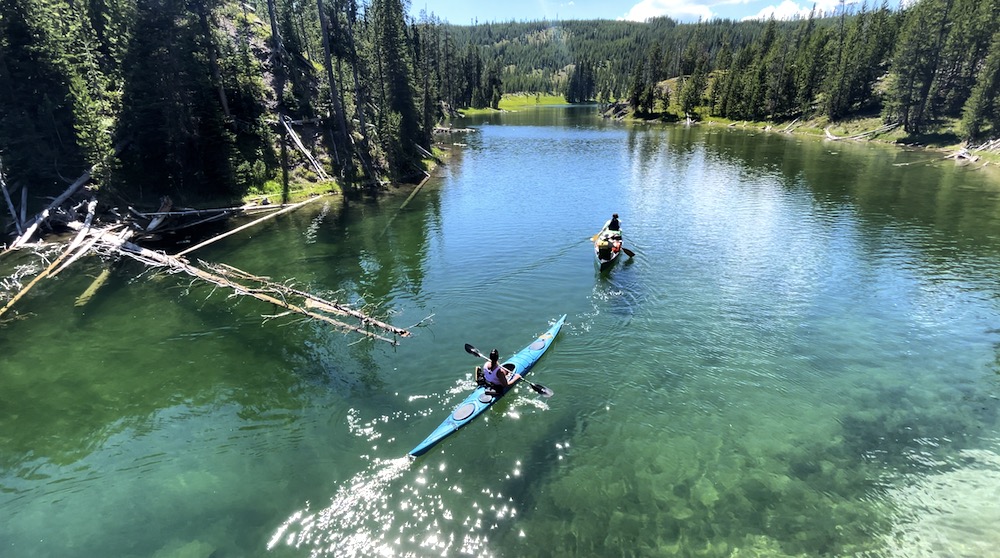
Visitors who take to the water must be aware of the risks associated with boating in high altitude environments, as water temperatures at this elevation is quite low and exposure to such waters can easily result in hypothermia, regardless of the time of year. Strong mountain winds often cause large waves that can capsize many small craft.
Guests who bring their own boat into the park will need to get an inspection prior to launching their craft in Yellowstone waters. In an effort to reduce the likelihood of spreading aquatic invasive species, the park requires an inspection of all watercraft that enters park waters. Boaters can speed up this process by arriving with a boat that is cleaned, drained and dry.
For those who didn’t bring their own watercraft, there are rental options at the Bridge Bay Marina for motor skiff rentals, as well as other options outside the park for canoe or kayak rentals and guided tours.
Swimming in Yellowstone
Many visitors to the world’s first national park enjoy a good sloshing in Yellowstone’s lakes, rivers or streams when conditions allow. While the park does not advertise most of its waters as suitable for swimming, a hot day on the trail often prompts a quick dip in one of the many waterways that dissect this strange wonderland. The NPS directs plunge-determined guests toward one of two bodies of water that are somewhat well suited for aquatic endeavors:
The Boiling River is found in the northern region of the park, near Mammoth Hot Springs, where its waters empty into the Gardner River. This area is currently off limits, and will likely remain so following the floods of 2022, which destroyed the road along which the swimming area is located.
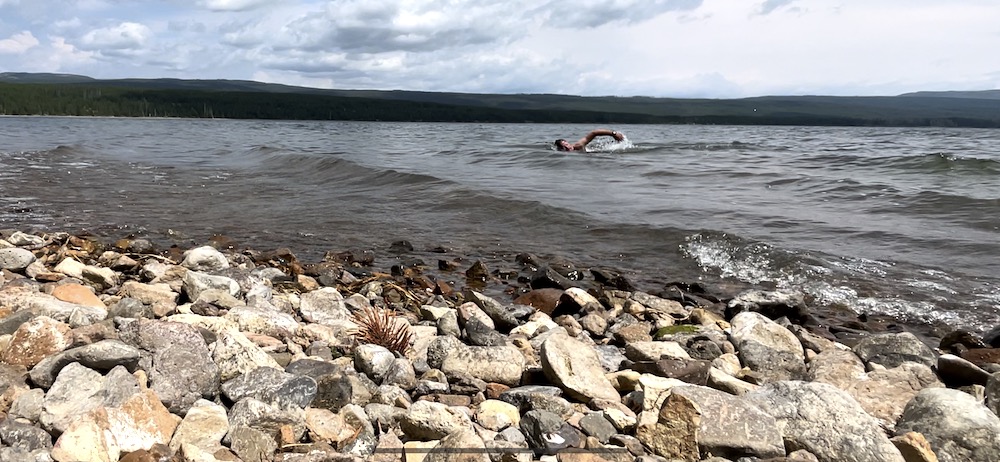
The Firehole River flows through the southwestern region of the park, collecting heated water from thousands of thermal features. This doesn’t make the river hot, but many will report that it is at least “somewhat warm”. Indeed, the Firehole does provide a nice temperature in which to kick about and is thus, a popular destination for folks in that area.
The Firehole swimming area is found along the Firehole Drive, which departs the Grand Loop Road about two miles south of Madison Junction. It is an incredibly scenic drive, and the designated swimming area is found toward the completion of the one-way drive, which leads back to the GLR.
Most other park waters will likely be frigid. Many of the larger bodies of water, such as Yellowstone Lake, never see temperatures above 60°F. Visitors who enter such waters must realize the risk of hypothermia associated with exposure to such waters. You are responsible for your safety and well-being while in the park.
While there are limitless lakes, rivers, streams and springs in Yellowstone, many are not suitable for the submerging of a human body. It is illegal to enter any hot spring in the park whose waters have not mixed with a non-thermal body. Swimming is also prohibited in the Bridge Bay Marina Channel. There are no lifeguards in Yellowstone. You are responsible for your own safety.
Auto Tour of the Grand Loop Road
An auto tour on the Grand Loop Road is the perfect way to experience the park’s splendor and explore its unique geological features, abundant wildlife, and awe-inspiring vistas.
As you enter the park through the northern entrance, you’ll be greeted by the stunning Mammoth Hot Springs, the first major stop on your auto tour of the Grand Loop Road.
Mammoth Hot Springs features terraces of travertine formations, created by hot water and limestone. Visitors can take a boardwalk tour of the area and marvel at the unique formations and vibrant colors.
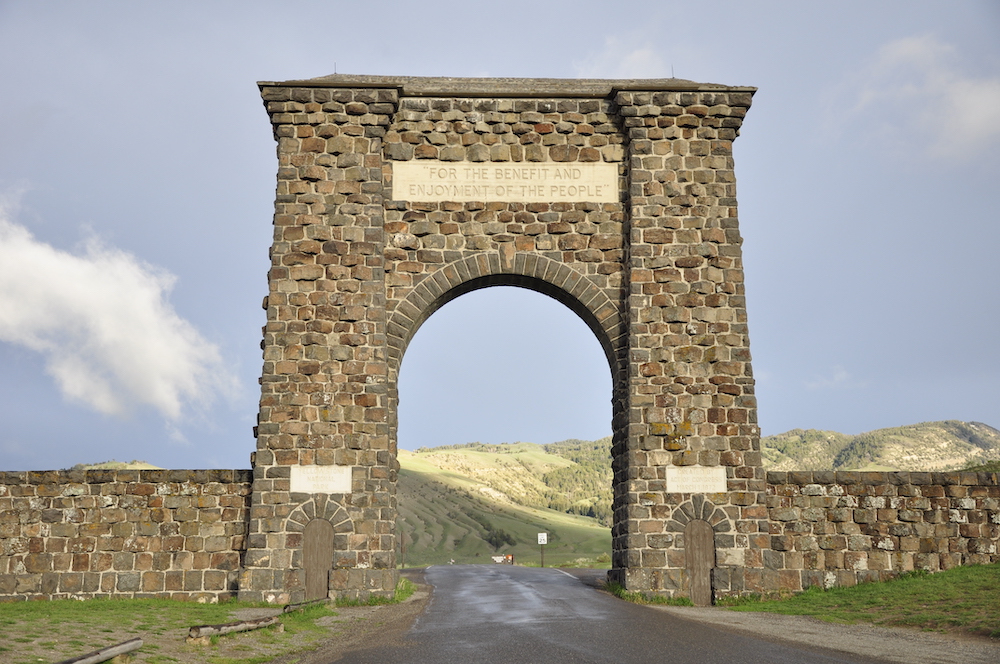
Continuing west on the loop road, visitors arrive at the Tower-Roosevelt area, located in the northeastern part of the park. This area offers scenic drives, hiking trails, and wildlife viewing opportunities. Visitors can take in the majesty of the Lamar Valley, known as the “Serengeti of North America,” and spot the park’s iconic wildlife, including bison, elk, and possibly wolves. Visitors can also marvel at the Petrified Tree, which is over 50 million years old.
The next major stop is the Mount Washburn, and then the Grand Canyon of the Yellowstone, where visitors can behold the striking waterfalls and colorful canyon walls. The canyon’s awe-inspiring beauty is a testament to the geological forces that shaped this area over millions of years. Be sure to stop at the Canyon Visitor Education Center to learn more about the area’s geology and natural history.
Next, visitors arrive at the Lake Village, located in the central area of the the world’s first national park. Here, visitors can enjoy the scenic beauty of Yellowstone Lake, the park’s largest body of water and the largest high elevation lake (7,000’+) in North America. Lake Village also features various hiking trails, fishing spots, and picnic areas.
Continuing south on the loop road, visitors arrive at the West Thumb Geyser Basin, situated on the shore of Yellowstone Lake. This geothermal area features hot springs, geysers, and other thermal features, offering visitors a glimpse into the unique geological features of Yellowstone. Some folks will want to swing over to Grant Village at this point to check out the small village and grab a drink or some gas.
The next major stop is the Old Faithful area, where visitors can tour the boardwalk around the Upper Geyser Basin, which is home to more than half of the world’s active geysers. Be sure to check the predicted eruption times for Old Faithful, along with four other predictable geysers, which are posted at the Old Faithful Visitor Center.
Finally, visitors arrive at the Norris Geyser Basin, located in the heart of the park. This area is the hottest and most active thermal area in Yellowstone and features an array of steam vents, hot springs, and geysers, including the famous Steamboat Geyser, which is the world’s tallest active geyser.
As visitors complete the loop, they can exit the park through the northern entrance and return to the town of Gardiner, Montana.
Yellowstone National Park’s Grand Loop Road is a scenic drive with many pullouts and overlooks along the way, providing visitors with ample opportunities to take photos and savor the stunning views. You’ll want to plan for a good two days, at minimum to do this drive. I’ve done it in one day, but that was just to see if it could be done. It took 12 hours, and I was absolutely unable to enjoy any of the sights along the way. So just take your time and plan for a good couple or three days.
A 45-mph park-wide speed limit ensures that this drive is slow. Adding to the crawling nature of this route are the “bison jams” as they are commonly termed in the park, due to the fact that they are often caused by wandering bison, who are no hurry for you.
This is the world’s first national park, and its unique geology, abundant wildlife, and awe-inspiring vistas, guarantee that a tour of Yellowstone National Park is an unforgettable experience that visitors will cherish for a lifetime.
Horseback Rides in Yellowstone
Nothing brings authenticity to the western experience like a good day spent on horseback, especially a day spent on horseback while exploring the world’s first national park. Visitors who wish to embark on such a mission can either bring their own stock, or simply sign up for one of the guided trips that are available inside or adjacent to the park.
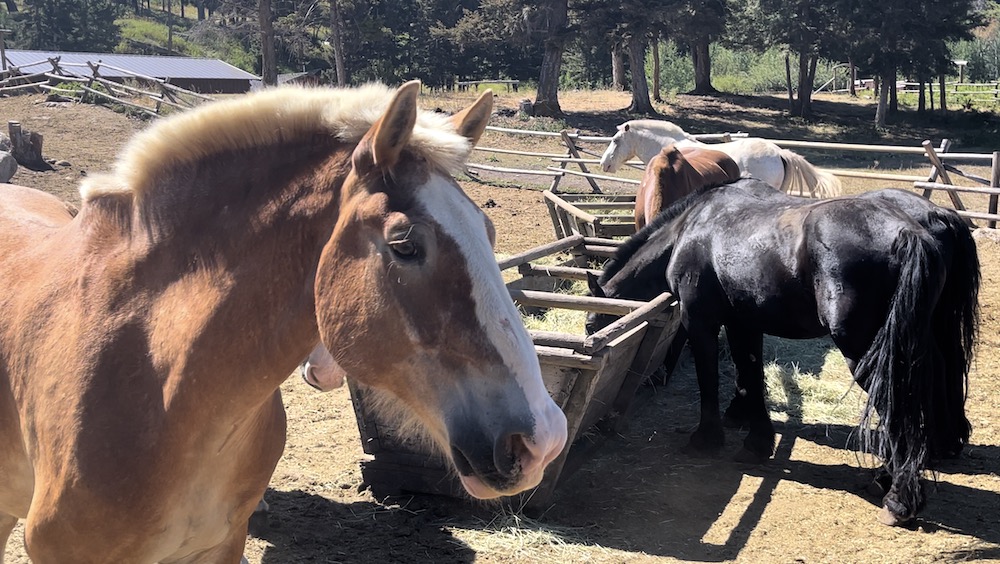
Those who seek guides to provide their journey into the wild west should first determine just how long they want to be on the back of their chosen steed. Available trips range from one or two hour options at Roosevelt and Canyon Villages, to week-long excursions with a few of the guide services based outside the park. These guides are permitted to operate within Yellowstone National Park, and often in neighboring National Forest land as well, which opens a world of opportunity for long-distance riding.
Folks who bring their own stock to the park must obtain a day ride permit or an overnight backcountry permit, depending on their chosen itinerary and provide proof of a negative EIA or Coggins test within the 12 month period prior to their trip.
Authorized Yellowstone Guide Services
NPS – Yellowstone – Horseback Riding
Wildlife Viewing in Yellowstone
Some days, Yellowstone literally seems like a zoo. While the premise that a national park and a zoo are comparable may seem preposterous, the sheer number of animals that can be seen from the comfort and safety of one’s automobile or from roadside pullouts in this park, is quite simply astounding.
Of all the national parks in the lower 48, Yellowstone is renowned for wildlife sightings that visitors remember for a lifetime. Thousands of bison roam the valleys and hills of Hayden and Lamar Valleys, often creating miles-long-traffic-jams, known as “bison-jams” in the park.
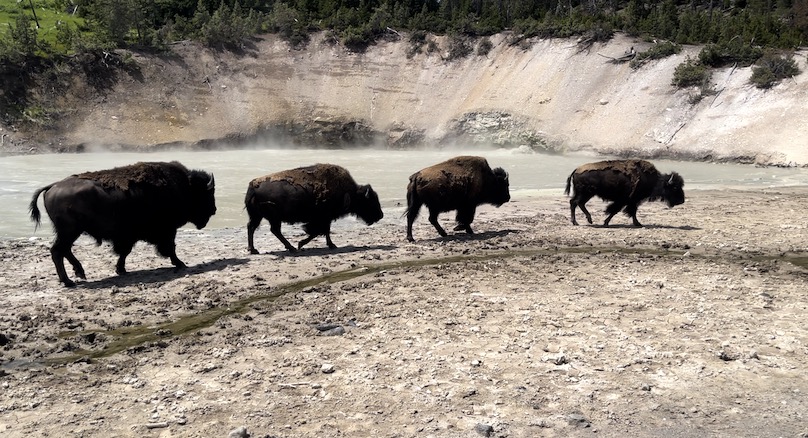
Grizzly and Black Bears sometimes find a reason to emerge from seclusion to forage in meadows along roadways, giving motorists-turned-photographers justifiable reason to stop in the middle of the road in search of their very own National Geographic cover photo.
That said, don’t drive through expecting to see anything, as this often will provide disappointment. Just keep the eyes peeled, and when you do see something, be polite enough to pull over as to not disrupt traffic. If outside your vehicle, keep in mind the safe viewing distances for various animals. Bears and wolves require a 100 yard safety zone, while all other park wildlife needs at least 25 yards.
Often, groups of enthusiasts will congregate in pullouts in Hayden and Lamar Valleys, as well as numerous other locations throughout the park. Don’t hesitate to pull over and observe these scenes for yourself, as there is usually something out there that is responsible for the gathering. Ask questions, as many of these folks are happy to share their knowledge and stories from the roadsides of the park.
Several companies offer tours that often include roadside wildlife viewing. It is never a bad idea to head out with the professionals, as this tactic can often save countless hours of needless driving, and such guides are well-informed of specific game routes and recent hot spots.
Guided Road Tours in Yellowstone
Photography in Yellowstone
It will likely come as no surprise to learn that visitors take a lot of photographs in Yellowstone. Guests from around the globe swarm boardwalks and viewpoints in search of the classic postcard image, and indeed, many succeed in capturing that perfect moment.
This often requires a bit of planning, or a great deal of patience. While drive-by photographers may get lucky with a great “spur of the moment” shot, many more successful photographers often have a good idea of what photograph they want, before they arrive at the scene.
Think of your subject, your lighting, and what shadows may be in your frame as you plan your specific shots, as the time of day presents drastic differences from location to location in the park. Make a list of the photographs you’d like to collect on your trip, and spend a bit of time researching how to get that perfect image.
For those who would appreciate the help of a professional, there are several companies that specialize in helping visitors get the perfect shot. Check out the companies below to find the one that suits your specific needs.
NPS – Yellowstone – Photography
Biking in Yellowstone
The good ole bicycle can provide a real benefit when visiting Yellowstone. A number of the park’s trails allow the two-wheeled contraption, and utilizing this vehicle can save a lot of time in many instances.
While the park offers no mountain biking trails, or no real bike trail at all in reality, many of the park’s old roads now allow bike travel. Trails such as the Bunsen Peak Trail, the Chittenden Road, the Fountain Drive, Natural Bridge Drive, the Fountain Freight Road and the Daisy Geyser Cut-off at Old Faithful are a few of the more popular rides in the park.
Most of these rides will offer easy access to some of the park’s slightly more-out-of-the-way attractions and provide rapid travel at the same time. This can allow the motivated trail-hound to cover more sights in a day.
